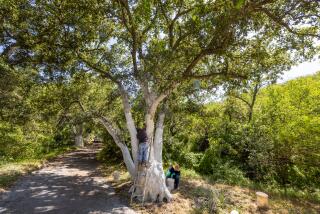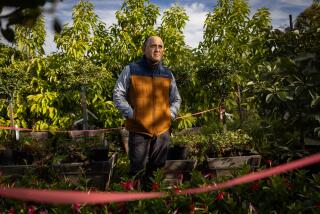Unleashing ‘Good Bugs’ to Battle Persea Mites
- Share via
Question: I’ve been told that my avocado trees are being attacked by persea mites. They have been dropping their leaves, which look like they have the measles. What do you suggest I do to control this pest?
D.G., Anaheim Hills
Answer: The persea mite (Oligonychus perseae) causes small dead spots to develop on the undersides of leaves along the midrib and main veins. As this pest’s numbers increase, the spots also appear between the veins. Each spot is covered by a fine, silvery webbing, which protects the mites underneath that are feeding and laying eggs. These mites begin to increase rapidly in spring and peak during the summer.
The mites cause significant leaf drop, which prompts the trees to produce new growth, which is in turn attacked by the mites. This process zaps the tree’s strength and causes increased fruit “sunburn” (less protection). The result is smaller harvestable fruit.
These mites seem to prefer Hass, Gwen and Reed avocados but can also develop significant numbers on Fuerte, Bacon and Zutano avocados.
Persea mites have also been known to develop large populations on grapes such as Thompson and Flame seedless and Chardonnay; deciduous fruits such as apricot, peach, nectarine, persimmon and plum; roses; citrus fruit; acacia; camphor; and liquidambar trees.
Control of this pest can be achieved by focusing on several fronts:
Keep trees well-watered during leaf flush, but reduce watering after mite-induced leaf drop until new leaves have regrown. Excessive nitrogen fertilizer can actually worsen the damage, so use nitrogen sparingly during leaf flush.
If mite damage is severe, consider releasing “good bugs,” such as predatory mites, to get the persea mites under control. Several predatory mites, such as Neoseiulus californicus and Galendromus helveolus, have shown promise in controlling this pest.
UC Riverside entomologist Mark Hoddle has observed in his research that N. californicus can reduce Persea mite damage to levels that do not result in as much leaf drop and is considerably less expensive.
Use of predatory mites may take up to three years to achieve good biological control. Washing leaves with a high-pressure water spray before releasing the “good” mites is recommended to break up mite webbing and wash off dust and mites that are on leaves. This procedure will also help control the persea mites.
One study by UC researchers concluded that the most cost-effective and environmentally friendly treatment for this mite is a high-pressure water treatment.
Insectaries selling predatory mites typically recommend releasing about 100 to 250 mites per tree. Predatory mites should be introduced when Persea mite populations are at low levels, when temperatures are cool and humidity is high (humidity favors the predator).
These good bugs are available through mail-order insectaries including:
* American Insectaries Inc., Escondido, (760) 751-1436
* Applied BioPest, Oxnard, (805) 984-9224
* Biotactics Inc., Riverside, (909) 320-1366
* Rincon-Vitova, Ventura, (800) 248-2847
If chemical controls are needed, horticultural oils appear to be the best control but should be used as a last resort, because it harms the good bugs as well. Consult a local California Certified Nursery Professional for further guidance in this area.
More information on persea mites is available at https://www
.biocontrol.ucr.edu.
Have a problem in your yard? University of California Cooperative Extension (UCCE) Master Gardeners are here to help. These trained and certified horticultural volunteers are involved with a variety of outreach programs, including the UCCE Master Garden hotline, which provides answers to specific questions. You can reach the hotline at (714) 708-1646 or send e-mail to ucmastergardeners@yahoo.com.


